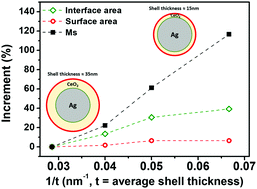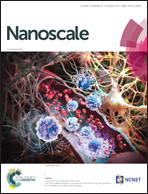Interface interactions and enhanced room temperature ferromagnetism of Ag@CeO2 nanostructures†
Abstract
Enhancement of room temperature ferromagnetism (RTFM) has been achieved with core–shell metal–oxide nanoparticles (Ag@CeO2). To enhance the magnetic properties, interfacial charge transfer is achieved via the formation of a core–shell interface. Furthermore, by varying the shell thicknesses, additional control of the RTFM can be obtained. The Ag@CeO2 core–shell nanoparticles are synthesized successfully via a two-step method. Ag nanoparticles (NPs) are first synthesized on a TiO2 substrate by a thermally assisted photoreduction method, and then CeO2 NPs are deposited on the surface of Ag NPs by chemical reduction. No surfactants or organic compounds are used during the synthesis. At the interface between the core and the shell, electron transfers from the Ag-p orbital to the Ag-d and Ce-f orbitals are evidenced by X-ray absorption spectroscopy and electron energy loss spectroscopy. Such interfacial charge transfer results in enhanced room temperature ferromagnetism in the Ag@CeO2 core–shell NPs compared to the magnetism arising for bare Ag or CeO2 NPs. This study suggests that tailoring the interface, the surface and their coupling in nanostructured metal–oxide core shell nanoparticles is an effective way to enhance their magnetic properties.



 Please wait while we load your content...
Please wait while we load your content...